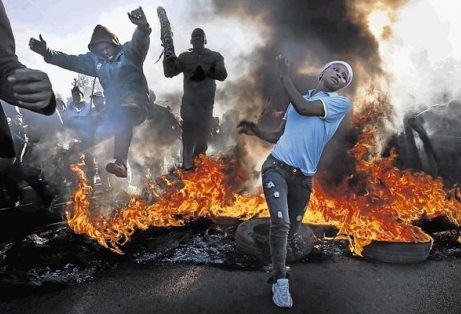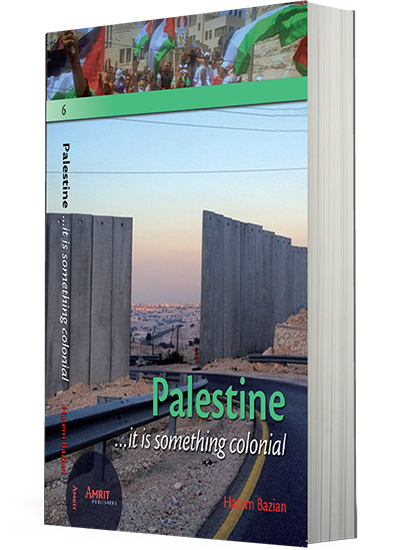The xenophobia and deadly violence engulfing South Africa brings to the fore the precarious conditions effecting immigrants and refugees across the globe. Immigrant numbers in South Africa vary from 2-5 million and include both legal and illegal arrivals with most making their way to the country searching for jobs and better living conditions. At a time when unemployment in South Africa is hovering around 24-26%, the worsening economic conditions and the perceptions that foreigners are taking jobs and opportunities away fuels the anti-immigrant campaign.
However, the focus on South Africa’s violence, which already claimed five lives and caused the flight of many immigrants, misses the broader issues at play in Africa and other parts of the world. The problem, and indeed, the crisis should be understood in relations to the failure and collapse of the post-colonial state and the result is the massive influx of immigrants from the global south to the ex-colonial motherlands and the global north. What are the real causes behind the massive flow of immigrants and refugees into South Africa, Europe, United States, Israel, Japan, Turkey and Gulf States? The flow of immigrants from Southern African states into South Africa, the last settler colonial project in Africa, is paradigmatic of the crisis and collapse of the post-colonial order, which calls for a deeper historical examination of the problem at hand.
Certainly, the driving force behind this massive human immigration movement is economic dislocation and political instability in the post-colonial states. The massive waves of immigrants are emerging from the collapsing post-colonial states, which, in economic terms, operated as a satellite unit connected to the ex-colonial motherlands providing raw materials and captive markets. The industrial global north incentivized a raw material based economic order and bribed its way into hospitable markets for its finished products in the post-colonial global south. In this context, the post-colonial economic order was determined by the colonial economy and then set in motion but subject to the established colonial antecedents.
Instead of thinking of the immigration crisis as a disconnected problem and pursue a state-by-state analysis, a much more robust understanding emerges once a longer historical trajectory is considered with the colonial discourse at the center. The post-colonial state economy was the colonial economy minus colonial troops and administrators. At the moment of independence, the colonial powers managed to stitch together their economic rights and interests within each colonized state in the global south. The next step was to cement these ‘rights’ through the utilization of colonially drafted, framed and codified international law that was written to maintain and legitimize colonial thievery and pillaging at the expense of indigenous populations.
The flag, stamp, presidential guards and plane in the global south were the trappings of independence while the economy and the livelihood of the people were the domain of the colonizers even in the post-colonial period. Examine the economies of most post-colonial states in the global south (including South Africa) and you will find that their raw material reserves are owned and operated by the global north and their markets totally dominated by the multi-national corporations. The best-case scenario for some global south states can be found in a multi-national corporation from the north locating a manufacturing base and providing cheap employment but at the expense of the environment and local production base.
The post-colonial state remained rooted in providing raw materials, a captive market for finished products for the colonial north. Consequently, the distorted economic foundation of the post-colonial state in the global south is tearing at the seam with immigration being one immediate visible outcome. The colonies never arrived at economic independence but only the perception of one.
The post-colonial picture was further muddled by a colonially constructed elite that was ready to continue the mode of economic operation he/she was educated under and accepted it to be the universal norm and standard. In addition, the elite and the ruling circles were nursed on corruption during the colonial period, and likewise were kept on the take in the post-colonial period or independence. Many who came into the leadership were first educated in the colonial north, employed during the colonial period by global north corporations and once in positions in power re-produced the same colonial patterns learned and internalized over generations.
The dynamics were further complicated during the cold war as post-colonial states got recruited to fight the wars on behalf of the global north: USA versus USSR. As a matter of fact, the Cold War was anything but cold in the global south and millions of post-colonial subjects died a very hot and suffocating death. Also, a byproduct of the Cold War in the global south and once coupled with the role of the military in the colonial period, is the elevation of military power and violence as the only tool for administering the society. The Cold War distorted further the emergent post-colonial state and introduced yet another level of dependence, internal conflicts and manipulations.
The centrality of military power and violence in the post-colonial state was born out of the colonial period and in sub-Sahara Africa can be traced to the emergence of the slave trade in the region. Important to recall that the slaves-for-guns strategy were facilitated by European powers to increase the regional war in East and Sub-Sahara Africa in order to boost the supply of slaves to the transatlantic market. In this context, European slave traders sold weapons to all parties in East and Sub-Sahara Africa which intensified the wars among them with the end result being human commodities, slaves, i.e. war captives from each side brought to the coast and sold for more guns to fight one another and bring more slaves to the coast.
Guns-for-slaves of old is transformed into military hardware, planes and special training to the post-colonial state to protect the colonially constructed economic interests and protect the handpicked and nurtured local elites. The national military in the post-colonial state is anything but national, rather, it functioned to protect the colonially trained elites who managed the post-colonial economic interests of the global north and were ready to burn cities and towns in the process.
Another dimension to the post-colonial economy is the preoccupation of the elites of wanting to imitate and replicate modes of development and progress present in the global north: The location of civilization itself, racial superiority and the imagined perfected ideal. This imitative approach further cements the existing colonial links in the post-colonial and centralizes the role of the colonizing state. Opting for an imitative project led to heavy dependence on the expertise of the ex-colonial motherland and the readiness to follow economic prescription on how it should be done, as well as the readiness to extend loans for the post-colonial state. By opening the door (assuming it was closed) once again to the colonial superior global north master to enter into the picture, the post-colonial returned willingly into the colonial and was ready to pay for it and take loans to do it.
In the colonial period, the colonizers had to bring into the mission an army, officers, administrators, spend blood and wealth to control and dominate the colony, then, begin to extract benefits while facing constant resistance. However, the post-colonial witnessed the ex-colonizer being invited, flown first class on the national airline, received with pomp and circumstance, put-up in five star hotels, served as a king by the independent and exotic natives, given free and unlimited time to pontificate his superiority on national TV, radio and newspaper and then handed handsome contracts and payments as an advisor or consultant to the country’s own structured dispossession.
In reality, the consultant, advisor, expert or more accurately ‘the economic hit man’ worked to entangle the post-colonial states in debt, dependency and failure by design projects. The colonial powers used army and brute force to rob and pillage their way into the global south, but in the post-colonial period, businessmen dressed in suits driving luxury cars did the dispossession by a stroke of a pen while sipping wine and eating caviar in five star hotels. Debt and loans were the magic elixir sold by the experts to help bring about development and progress in the global south while all along it was a scam that put the subprime mortgage and derivative players to shame for the rates of return with no questions asked or any investigation. The scheme was protected by the IMF, World Bank and a host of other international organizations, which made sure that the robbery was legal and sanctioned by international law. And in the case that a country is unable to pay then a debt-for-equity swap is introduced as a remedy: The most sophisticated plan to ‘legally’ rob a nation and advertise on TV and media as a rescue plan!
In the past, the colonial power had to use its own resources to extract the resources but in post-colonial states the responsibility was shifted to the local elites. Debt and loans served as tools to maintain the colonial in the post-colonial, while making sure that the elites in the south are incentivized to play along by bribes and commissions deposited into Swiss, British, German, French, Italian and American secret bank accounts managed by the same banks or subsidiaries of the financial institutions originating the loans in the first place. Often the loaned money never left the safes of the banks that extended the loans since it also prescribed the companies that maybe hired to undertake the development project; likewise, the companies were directly or partly owned subsidiary of the bank making the loans.
Not to leave the native expert out, but in case after case a local interlocutor was available to assist in formulating the proposal and making sure the ‘local’ view is present. The native expert, who most likely studied and graduated from Oxford, Sorbonne, and Harvard business school or economics departments and endowed with knowledge on how best to lead the inferior global south out of its supposed backwardness by increasing its dependence and imitation of the global north. Business and economic schools that graduate economic hit man and unleash them onto the world with no ethical or moral compass to counter human greed and callousness.
The native expert role is to map the tribal landscape, religious divisions, navigate the local elites, and know who must be invited to tour the global north and, as well, be open to sexual exploitation, drug and luxury corruption schemes. Entangling the elite in corruption schemes surely is good for business and will land the deal 100% of the time. Often with the help of the native expert the global north corporations, banks and governments are in total control of any contract negotiations and all sides sitting at the table are paid for and compromised to sign the deal that is most adversely affecting the local economy. This is not an open market economy or capitalism at play but the most sophisticated mafia-like civilized shake down and robbery scheme planned, produced and executed with laser precision.
Shifting to the constant local and regional conflicts and bloodletting in post-colonial states, which are often described in religious, tribal and ethnic terms but in reality are shaped, produced and nurtured in the colonial womb. For beginners, the post-colonial borders are the same colonial borders that were shaped by competing European colonizing interests and crafted around local tribal, religious and ethnic fault lines to maximize penetration, control and domination. The tribal, ethnic, religious and cultural post-colonial borders were shaped by the colonial powers to maximize internal rivalries and press for constant conflicts so as to keep the need to meddle and control each country’s affairs in the post independence period. In reality, the drawing of borders was done with the idea of keeping the colonized society fragmented and constantly needing the military and/or civil intervention of the ex-colonial motherland. While the colonial military power was expelled from the country; nevertheless, through this process the structure set in place made sure to keep the colonizers hanging around in the windows, the driveway and for sure cooking the post-colonial dinner of dispossession in the civilized colonial kitchen.
The majority-minority power relations in the post-colonial states were crafted in the colonial period and often with the specific goal of maintaining the colonizers interests by design. On the one hand, an empowered group, a minority or a small handpicked colonized elite from the majority, translates to a constant avenue for intervention in the military, economic and political affairs since all lacked the popular mandate and legitimacy from the population. The right to rule was achieved through the schemes discussed above and maintained through brute force and military power, training and expertise provided by the ex-colonial power for the purpose of preserving and protecting the global north economic interests.
Wherever you find a majority-minority conflict whether religious, tribal, cultural, linguistic, economic and political in the global south look for the colonial footprints first before attempting any dumbed down analysis of the causalities. In addition, ask the question about the nature of the economic market in the region, the type of natural resources and the multi-national corporations interest before searching the religious text, tribal history or past cultural differences among the people dying and maimed in the process. Colonial merchants of death are at work in the post-colonial and utilize all existing fault lines to maximize the bottom line returns on investments.


